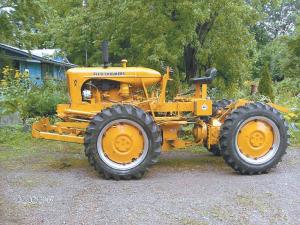2017 - Volume #41, Issue #4, Page #36
[ Sample Stories From This Issue | List of All Stories In This Issue | Print this story
| Read this issue]
4-WD Articulated Log Skidder
 |
 |
He built it out of two Farmall F12 rear ends and an Allis-Chalmers WC engine and transmission. It’s equipped with a 7-ft. wide “pusher blade” on the front and an 8,000-lb. electric winch on the back with 150 ft. of 3/8-in. cable.
The skidder’s engine is coupled to both rear ends by No. 100 roller chain at a 1 to 1 ratio. The machine steers by bending in the middle via an orbital steering valve and two hydraulic cylinders. The two halves of the skidder are independent of each other, so all wheels stay on the ground.
The two Farmall rear ends face each other and are connected by a shaft held in place by a pair of bearings. Double U-joints are located between the shaft and the skidder’s back end.
To make the articulation joint, Sundberg used a torch to cut out a 3/4-in. thick round steel plate and welded it on between the rear ends. He machined holes in the plate and installed needle bearings, then welded a pair of hinge pins into the center of the plate—one on top and one on the bottom. He also machined a 6-in. long pipe to fit the bearings, which support a shaft that connects both rear ends.
“It operates much like a big articulated 4-WD tractor. I built it about half the size of a factory-built log skidder because it’s easier to get around our woods and trails with a smaller machine,” says Sundberg. “My wife and I use it to cut our own firewood, about 10 to 12 cords every year. With the winch, we don’t have to drive up to the log to hook up. We just pull the log out to the trail and go. We also use the skidder to PTO-drive our wood processor.”
The steering wheel is off a Simplicity riding mower. “It steers so easy that I can use just one finger. The steering wheel won’t jerk out of my hands, no matter how rough the ground is,” says Sundberg.
The pusher blade is raised and lowered by a pair of hydraulic cylinders. “After we winch about 10 trees in from the woods, I use the blade to push them into a pile and then cut them to length,” he says.
Sundberg has displayed the skidder at several antique threshing shows and says many people tell him it looks factory-built.
“I spent almost three years collecting all the parts I needed to build it. I spent about $4,000 to build it and used only high-quality parts because I wanted to do the job right.”
Contact: FARM SHOW Followup, Gerald Sundberg, 2507 Lauren Rd., Duluth, Minn. 55804 (ph 218-525-4133; geraldsundberg911@yahoo.com).

Click here to download page story appeared in.

Click here to read entire issue
To read the rest of this story, download this issue below or click here to register with your account number.




